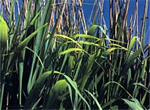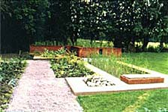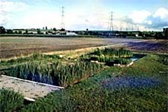Call us on+44 (0)1527 529809
Reed Bed Systems
Reed Bed Sewage Treatment Systems
The treatment of various types of pollution in water has been carried out naturally for a considerable number of years by differing types of plant life. Over the past 30 years these natural systems have been successfully harnessed to treat sewage and many other pollutants in wastewater.
Click here for more info: Different Sewage Treatment Systems – simply explained!
 How does it work?
How does it work?
Reed bed treatment systems have grown in popularity in recent years, although they have been around naturally for a considerable time.
In a number of cases they have been used as tertiary treatment following conventional treatment systems, particularly at smaller treatment works. In the UK one Water Company has built over 300 small packaged treatment works, each with its own reed bed system for tertiary and surface water treatment, however they can be built as a complete system with some form of primary treatment to remove the gross pollutants, followed by a reed bed treatment system.
All reed beds must be carefully constructed to ensure effective and full treatment of the liquors. There are two types of reed bed, namely vertical flow and horizontal flow systems. One disadvantage of these systems is the large land area required for correct treatment, and any designer must take this into account when choosing and designing the system.
The principle of the treatment of sewage by reed beds is relatively simple. The Common Reed (Phragmites Australis.) has the ability to transfer oxygen from its leaves, down through its stem, porous speta and rhizomes, and out via its root system into the rhizosphere (root system.)
As a result of this action, a very high population of micro-organisms occurs in the rhizosphere, with zones of aerobic, anoxic, and anaerobic conditions. Therefore with the wastewater moving very slowly and carefully through the mass of reed roots, this liquid can be successfully treated, in a manner somewhat similar to the conventional biological filter bed systems of sewage treatment plants.
Earlier reed bed sewage treatment systems used the horizontal flow type of reed bed, where the liquid flows horizontally through the bed, but it is essential that any form of treatment of sewage should have the capability to not only treat the sewage effectively, but also that its maturation time should be kept to a minimum. To achieve this the reed plants are partially pre-grown, and also with the development of a vertical reed bed system, this maturity of the total system can be more readily achieved.
Reed Bed Sewage Treatment Systems can be used to treat a variety of pollution loadings, but great care must always be exercised in their design and implementation.
FAQ about Reed Bed Sewage Treatment Systems
Do Reed Bed Sewage Treatment Systems smell and produce malodours?
Not if they are correctly designed to treat the loadings from the site.
Will we see the sewage on the reed bed?
The reed beds are designed so that the liquid flows through the bed where the roots exist, not over the top. Very occasionally in the early years of the reeds growth, it may be advisable to temporarily flood the bed, to rid it of weeds, but after these early periods this will not be necessary.
Why is it necessary to fence the reed beds in?
This is essential to stop animals, particularly rabbits, eating the roots (which they love.) and people from walking on or interfering with the reed bed, where the risk of contact with the sewage is to be avoided.
If pumping is required why is it necessary to have two pumps?
In any system, with a mechanical item of plant, it is always essential to have a standby system readily available, so that in the event of breakdown of this item, the standby item will come into operation automatically, thereby ensuring continuity of treatment of the sewage. This is also considered essential, to comply with the requirements of the E.A. as well as ensuring full continuity of treatment of the sewage.
Will the maintenance costs of the system be the same as a conventional system of treatment?
Generally the maintenance costs will be reduced; correctly designed reed beds have been shown to have considerably less operational costs.
Are there any problems with reed bed sewage treatment systems?
The main problem with reed beds is that they do require large areas of land, compared with a conventional or packaged sewage treatment works. However provided this land is available, on the whole they produce far less problems than other systems.
What about discharging chemicals into a reed bed sewage treatment system?
A reed bed sewage treatment system will have the same constraints as any other system, in as much as the discharge of certain chemicals must be restricted.
Photographs of differing types of reed bed sewage treatment systems

An unobtrusive complete horizontal and vertical reed bed sewage treatment system, installed at a hotel and serving a population of 24.
 An attractive horizontal and vertical reed bed sewage treatment system followed by a pond (foreground)
An attractive horizontal and vertical reed bed sewage treatment system followed by a pond (foreground)
 A horizontal reed bed sewage treatment system serving a population of approximately 15 persons.
A horizontal reed bed sewage treatment system serving a population of approximately 15 persons.
Vertical and Horizontal Beds System
Details are shown below of some examples of varying types of Reed Bed Sewage Treatment Systems, which offer an effective form of treatment, and in future years reduced maintenance costs for the sites. When pumping is carried out within the system for two or more properties, it is always advisable that a twin pump installation, with a duty / standby arrangement be considered, to avoid any problems.
Sewage Treatment Works with a Tertiary Reed Bed
This system is similar to those used by many Water Companies, where the main treatment of the sewage is normally undertaken in a packaged type of sewage treatment plant, and the reed bed is used to act as a tertiary treatment module.
Any excessive storm water that flows into the sewage works, by-passes the main treatment unit (to avoid hydraulically overloading it) and, as they are usually considerably weaker in strength, these excess flows are then treated in the reed bed.
Please note: Consultation with the Environment Agency is always necessary before implementing any scheme.
SPE can undertake a site visit and advise / specify / install accordingly.
© 2025 SPE Ltd | Privacy Policy | Quality Policy | Environmental Policy | Designed by SPE Ltd


